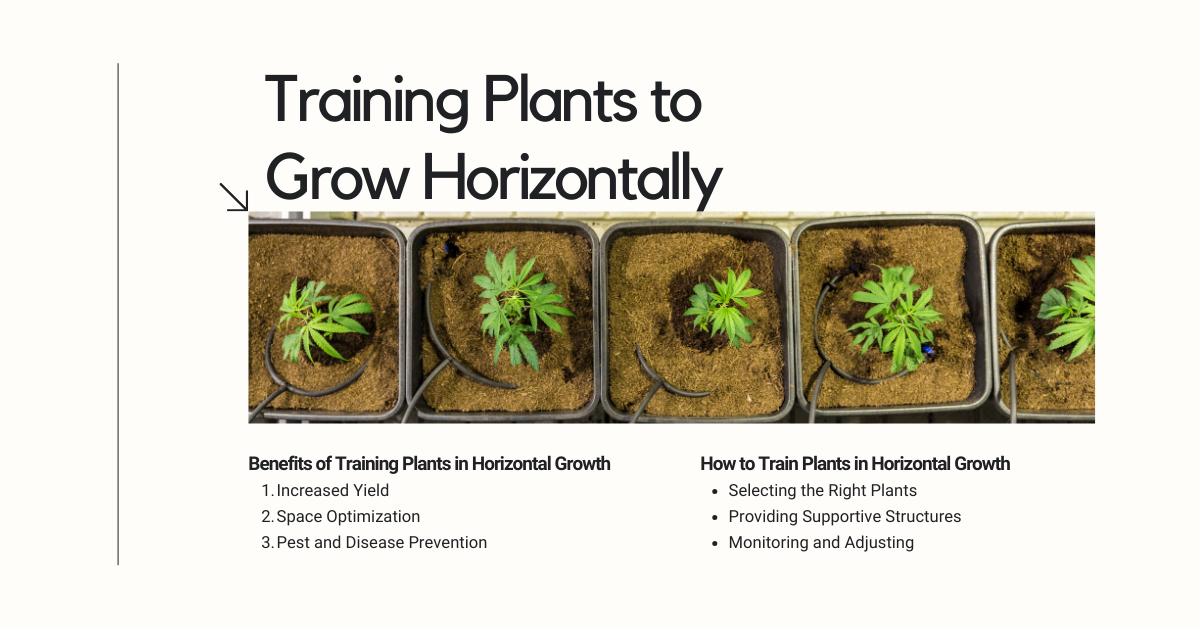Estimated reading time: 6-7 minutes
When it comes to gardening, available space is often limited. Whether you have a small backyard or a balcony garden, maximizing space is crucial. An effective technique is to train plants to grow horizontally. By encouraging plants to spread out instead of growing vertically, you can make the most of the available space and increase your overall yield. In this article, we will explore the benefits of training plants in horizontal growth and provide a step-by-step guide to effective implementation. Additionally, we will discuss the types of plants suitable for this method and the necessary care and maintenance.
Benefits of Training Plants in Horizontal Growth
Increased Yield
One of the main advantages of training plants in horizontal growth is the increased yield. When plants are allowed to spread, they have more access to sunlight and air circulation, which are essential for photosynthesis and the overall health of the plants. This increased sunlight and air can lead to larger, healthier plants and a higher yield.
Furthermore, horizontal growth can also result in more efficient nutrient utilization. As the plant spreads, it can absorb nutrients from a larger area of the soil, leading to healthier and more productive plants.
Space Optimization
Training plants in horizontal growth allows you to optimize the available space. Instead of taking up vertical space, plants can be trained to grow along trellises, fences, or other support structures. This vertical growth can help create a living wall or green privacy screen that provides privacy and shade while still allowing you to grow a variety of plants.
Additionally, horizontal growth can enhance the aesthetic appeal of your garden. With careful planning and arrangement, you can create beautiful patterns and designs with your horizontally growing plants.
Pest and Disease Prevention
Plants trained to grow horizontally are less susceptible to certain pests and diseases. By keeping the foliage off the ground, you can reduce the risk of soil-borne diseases and pests that thrive in moist environments. Moreover, increased air circulation can help prevent moisture buildup that can lead to fungal diseases. Overall, training plants in horizontal growth can contribute to creating a healthier growth environment.
Additionally, horizontal growth makes it easier to detect and combat pests and diseases. As the plants spread, you can easily inspect the leaves and stems for signs of infestation or illness.
This post could also be helpful to understand
How to Train Plants in Horizontal Growth
Selecting the Right Plants
Not all plants are suitable for horizontal training. Look for plants with flexible stems and a natural inclination to spread. In addition to flexibility, consider the growth rate and size of the plant. Fast-growing and large plants can quickly fill the available space, while slow-growing and small plants may not provide the desired coverage.
Providing Supportive Structures
To train plants to grow horizontally, you need to provide supportive structures such as trellises, stakes, or fences. These structures help guide the growth of the plants and prevent them from falling over. Ensure that the supportive structures are stable and capable of bearing the weight of the plants as they grow. Also, consider the height and width of the supportive structures. They should be large enough to accommodate the plant's growth but not so large that they overshadow the plants or take up too much space.
Starting Early
It's best to begin training plants in horizontal growth when they are young and still flexible. As the plants grow, gently guide their stems along the supportive structures and secure them with soft twine or string. Be careful not to damage the stems or leaves of the plants during this process. Remember to be patient and consistent. Training plants in horizontal growth takes time and regular attention. Avoid forcing the plants in a specific direction or applying too much pressure.
Regular Pruning
Regular pruning is crucial when training plants in horizontal growth. By removing excessive growth and redirecting the plant's energy, you can encourage lateral branching and prevent the plant from becoming top-heavy. Trim upward-growing shoots and remove dead or diseased branches. In addition to pruning, consider pinching the tips of the plants. This can stimulate bushier growth and promote plant spread.
Monitoring and Adjusting
Monitor the progress of the plants and make adjustments as needed while they continue to grow. Some plants may require additional support or training as they spread further. Be proactive in caring for the horizontal growth of the plants and ensure they receive appropriate support throughout the entire growth phase. Also, keep an eye on the health of the plants. If you notice signs of stress or disease, take appropriate action promptly. This may include adjusting the position of the plants, providing additional nutrients, or treating pests or diseases.
Harvesting with Care
When it's time to harvest, be mindful of the horizontal growth of the plants. Also, consider the timing of your harvest. Harvesting too early or too late can affect the quality and quantity of your yield. Monitor the plants closely and harvest when the flowers reach their peak.
Training plants to grow horizontally is a valuable technique for maximizing space in your garden. By encouraging plants to spread out rather than grow vertically, you can increase your overall yield, optimize your available space, and prevent pests and diseases. Remember to choose the right plants, provide support structures, start early, prune regularly, monitor and adjust, and harvest carefully. With these steps in mind, you can successfully train your plants to grow horizontally and enjoy a bountiful garden. Furthermore, this method can also enhance the aesthetic appeal of your garden and make it easier to manage pests and diseases. Happy gardening!
Disclaimer
This website's content is for informational use only and should not be considered medical or legal advice. Always consult a healthcare professional for health-related issues. Be aware of local regulations regarding cannabis cultivation. We are not liable for any actions taken based on this information.

